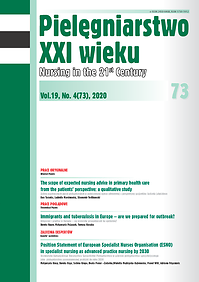Nutritional and care problems in infants with lactose intolerance
DOI:
https://doi.org/10.2478/pielxxiw-2020-0030Keywords:
lactose intolerance, infant, care problems, calciumAbstract
NUTRITIONAL AND CARE PROBLEMS IN INFANTS WITH LACTOSE INTOLERANCE
Aim. The purpose of the paper was to learn about nursing and nutritional problems in children with lactose intolerance.
Material and methods. The study included a group of 343 parents, 320 (93.3%) women and 23 (6.7%) men. A self-written questionnaire containing 27 questions was used for the study. The comparison of responses in the groups was performed using the chi-square test or the Fisher’s exact test where the expected low rates appeared in the tables. The analysis was performed in the R software, version 4.0.2.
Results. The most common symptoms affecting the respondents’ children were: abdominal pain (77.3%), abdominal distension (73.5%), overfl ow in the abdomen (49%), and mucus-mixed stools (45.5%). The symptoms caused the child’s anxiety during sleep in 52.5%, problems with attaching to the breast in 30.3%, and buttocks burns in 23.9%. Statistical analysis confirmed a significant relationship between education and age and the source from which the respondents obtained information on lactose intolerance (p<0.05). Statistical analysis showed that the financial situation had no effect on calcium supplementation in breastfeeding women while on a lactose-free diet (p>0.05). It is worth noting, however, that only 10.5% of the respondents declared calcium supplementation while on a lactose-free diet.
Conclusions. It is important to confi rm the diagnosis with an examination, as an incorrect diagnosis may lead to a number of problems without obtaining the desired effect. In children with symptoms of lactose intolerance, meeting the daily calcium requirement is essential.
References
1. Czerwionka-Szaflarska M, Rekowska M. Czy pamiętamy, jak ważna jest laktoza w diecie niemowląt i małych dzieci. Standardy medyczne, Pediatria. 2018;15;787-796.
2. Fidler-Witoń E, Mądry E, Krasińska B, Walkowiak J. Nietolerancja laktozy i jej uwarunkowania. Family Medicine & Primary Care Review. 2011;13(2):308-310.
3. Rychlik U, Marszałek A. Nietolerancja laktozy - współczesny stan wiedzy. Diagnostyka laboratoryjna. 2013; 49(1):71-73.
4. Zatwarnicki P. Nietolerancja laktozy – przyczyny, objawy, diagnostyka. Piel. Zdr. Publ. 2014; 4(3):273-276.
5. R Core Team (2020). R: A language and environment for statistical computing. R Foundation for Statistical Computing, Vienna, Austria. URL https://www.R-project.org/.
6. Czerwionka-Szaflarska M, Adamska I. Ostra biegunka u dzieci – najnowsze wytyczne. Forum Medycyny Rodzinnej. 2009; 3(6):431-438.
7. Marasz A. Częstość i obraz kliniczny hypolaktazji u dzieci, młodzieży i studentów ze Szczecina. Pom J Life Sci. 2015;61(2):207-213.
8. Baldan A, Tagliati S, Saccomandi D, i wsp. Assesment of Lactose-Free Diet on the Phalangeal Bone Mineral Status in Italian Adolescents Affected by Adult-Type Hypolactasia. Nutrients. 2018;10:558.
Downloads
Published
Issue
Section
License
Copyright (c) 2020 Authors

This work is licensed under a Creative Commons Attribution-NonCommercial-NoDerivatives 3.0 Unported License.




